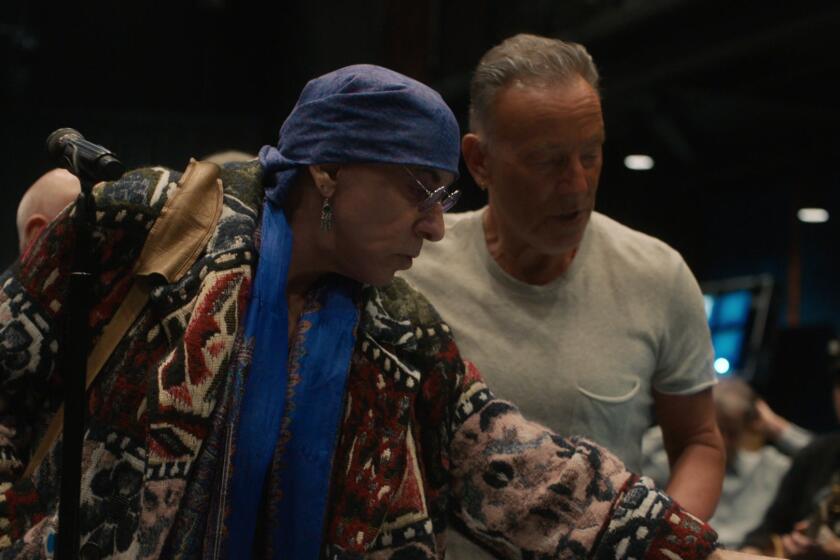Getting a ‘Wild’ look
When Spike Jonze set out to create live-action versions of the classic creatures from “Where the Wild Things Are” for his movie adaptation of the beloved children’s book, the writer-director had a very clear image in mind -- of what he didn’t want.
In 2004, around the time he also started co-writing its script with novelist Dave Eggers, Jonze rejected a number of submissions from a Hollywood special-effects company for being, well, “too creature-y.” Jonze thought they simply failed to capture a bestial je ne sais quoi found in Maurice Sendak’s 1963 picture book about Max, a little boy in a wolf costume who misbehaves and imagines himself transported to a faraway land where he becomes the king of all Wild Things.
“I wanted the monsters to retain the strange design that Maurice had created,” he said. “Weird, cuddly, charming. Looking at each other out of the corner of their eye. They’d be almost, like, conspiring. You don’t know if Max has total control over them.”
To ensure his monsters would have the proper “soul,” though, Jonze decided he needed an illustrator from outside the movie biz to draw mock-ups first. Over dinner, Jonze’s friend Karen O, lead singer of the alt-rock trio the Yeah Yeah Yeahs, and Julian Gross of the noise rock band Liars steered the director toward their pal Sonny Gerasimowicz.
He wasn’t a professional creature creator or artist. A former graffiti writer turned ad agency creative, Gerasimowicz was a kind of closet artiste with only one illustration for a magazine article to suggest his skill. Offered the chance to work with the zeitgeist-riding auteur, Gerasimowicz didn’t present him a polished portfolio. He showed Jonze rough pencil drawings of the Wild Things. And the lo-fi renderings struck just the right nerve. “I sent him sketches that were, like, things I drew while I was on the telephone. Like on scraps of paper,” Gerasimowicz recalled.
“When it comes down to something as delicate as tone, it became clear we had to find someone who had the right aesthetic,” Jonze said. “It’s finding people that have the right judgment, even if they’ve never done the specifics.”
Gerasimowicz landed the job in early 2005, the mandate being not to slavishly imitate Sendak’s singular style, more to articulate the creatures’ distinct personalities as per the script (it helped that Jonze physically acted out each character for him). In turn, Gerasimowicz drafted scores of monster drawings: previsualizations for Photoshop-version Wild Things, the stage during which such crucial details as their fur, feathers, musculature and eyes would be decided.
Then the two traveled to Connecticut to show Sendak the renderings and get his blessing. The then-76-year-old writer-illustrator made some tweaks -- suggestions about the muzzle on a bull-like Wild Thing and the feathers on the rooster Thing not being “flamboyant” enough -- but remained markedly nonproprietary. “His attitude is so contrary to protecting anything,” Jonze said. “His assignment to us was, ‘Take this, make it your own. Make it something personal.’ ”
In 2006, the project landed at Warner Bros. and monster production began at Jim Henson Co.’s Creature Shop. Gerasimowicz was kept on as head creature designer, overseeing work by some of the foremost practitioners in the business. Nevermind that he had absolutely no experience. Or that the expense of making the monsters accounted for the largest part of the movie’s production costs. Or that his staff wasn’t exactly certain where he fit in.
“I would give them aesthetic direction, ‘What if we kind of did this a little bit?’ And they’d be, like, ‘That’s a cool thought.’ But they would keep moving with what they were doing,” Gerasimowicz said.
With principle photography in Australia approaching in the spring of 2006, anxiety set in. Jonze had precise ideas about the way the Wild Things should look, i.e., “not like they were guys in suits.” But Jonze and Gerasimowicz’s lack of familiarity with how special effects are created resulted in sleepless nights during the characters’ fabrication.
“It was so hard!” Gerasimowicz exclaimed. “They show us a bare-bones suit and it would be the scariest thing in the world because it’s just a big foam thing. Not doing this ever before, it was hard to visualize.”
“We freaked out every step of the way,” Jonze added. “By the time we got to Australia, we were nervous wrecks.”
Compounding matters, the actors who were to perform in the Wild Thing suits had to be in costume up to 12 hours a day. Suits weighed up to 150 pounds and temperatures reached triple digits. When one of the actors dropped out at the last minute, Gerasimowicz’s job description changed again: He stepped into the role of Alexander, a small, snarky goat in the film. “Sonny has a demeanor similar to that character,” Jonze said. “I always describe him as a disgruntled Muppet.”
For anyone familiar with Sendak’s book, Jonze’s “Wild Things,” which opens Oct. 16, will be a marvel. The characters -- voiced by such actors as James Gandolfini, Forest Whitaker and Lauren Ambrose -- seem comfortingly familiar and yet occupy a totally unique movie universe, a vivid live-action extrapolation of Sendak’s classic work. Especially the creatures’ emotive faces. Asked if CGI was responsible for their expressiveness, however, Jonze grew cagey.
“The faces were static when we shot them and we put the faces on in post-production,” he said. “I didn’t want to have CGI faces where it’s synthetic fur. So it’s more manipulating what we’d shot in-camera.
“It’s not like it’s a big secret. But I want to let that come out later. I don’t want the attention to focus on that.”
--
More to Read
Only good movies
Get the Indie Focus newsletter, Mark Olsen's weekly guide to the world of cinema.
You may occasionally receive promotional content from the Los Angeles Times.











